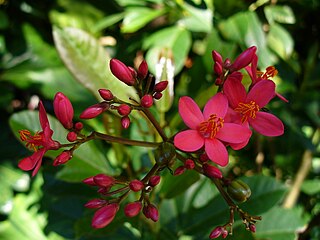| Manihot | |
|---|---|
 | |
| Manihot palmata | |
| Scientific classification | |
| Kingdom: | Plantae |
| Clade: | Tracheophytes |
| Clade: | Angiosperms |
| Clade: | Eudicots |
| Clade: | Rosids |
| Order: | Malpighiales |
| Family: | Euphorbiaceae |
| Subfamily: | Crotonoideae |
| Tribe: | Manihoteae |
| Genus: | Manihot Mill. 1754 not Adans. 1763 [1] |
| Type species | |
| Manihot esculenta | |
| Synonyms [4] | |
Manihot is a genus in the diverse milkspurge family, Euphorbiaceae. It was described as a genus in 1754. [5] [3]
Contents
Species of Manihot are monoecious [6] trees, shrubs and a few herbs that are native to the Americas, from Arizona in the United States south to Argentina and Uruguay. [4] The best known member of this genus is the widely cultivated cassava (Manihot esculenta). [7]
Manihot species are used as food plants by the larvae of some species of Lepidoptera including Endoclita sericeus and Hypercompe hambletoni .
- Species [4]
- Manihot acuminatissima Müll.Arg. – Goiás, Bahia
- Manihot aesculifolia (Kunth) Pohl – Mexico, Central America
- Manihot alutacea D.J.Rogers & Appan – Goiás
- Manihot angustiloba (Torr.) Müll.Arg. – Mexico, Arizona
- Manihot anisophylla (Griseb.) Müll.Arg. – N Argentina
- Manihot anomala Pohl – South America
- Manihot attenuata Müll.Arg. - Goiás
- Manihot auriculata McVaugh – Jalisco, Nayarit
- Manihot baccata Allem – Fr Guiana, NE Brazil
- Manihot brachyandra Pax & K.Hoffm. – Bahia
- Manihot brachyloba Müll.Arg. – Central Amer, Dominican Rep, N South America
- Manihot brasiliana Mendoza et al. - Goiás, Brazil
- Manihot breviloba – Sergipe
- Manihot caerulescens Pohl – Brazil, Paraguay
- Manihot carthagenensis (Jacq.) Müll.Arg. – N South America, Trinidad, Curaçao
- Manihot catingae Ule – Bahia, Minas Gerais
- Manihot caudata Greenm. – N Mexico
- Manihot cecropiifolia – Goiás, Distrito Federal
- Manihot chlorosticta Standl. & Goldman – Mexico
- Manihot compositifolia Allem – Bahia
- Manihot condensata D.J.Rogers & Appan – Bolivia
- Manihot congesta Mendoza et al. - Goiás, Brazil
- Manihot corymbiflora Pax & K.Hoffm. – Rio de Janeiro
- Manihot crassisepala Pax & K.Hoffm. – México State, Morelos, Jalisco
- Manihot crotalariiformis Pohl – Minas Gerais
- Manihot davisiae Croizat – Arizona, Sonora, Chihuahua, Sinaloa
- Manihot diamantinensis Allem – Bahia
- Manihot dichotoma Ule – NE Brazil
- Manihot divergens Pohl – Goiás, Distrito Federal, Minas Gerais
- Manihot epruinosa Pax & K.Hoffm. – Piauí, Ceará, Paraíba, Pernambuco, Bahia
- Manihot esculenta Crantz – from Mexico to Brazil
- Manihot falcata D.J.Rogers & Appan – Goiás, Distrito Federal
- Manihot filamentosa Pittier – NW Venezuela
- Manihot flemingiana D.J.Rogers & Appan – Mato Grosso
- Manihot foetida (Kunth) Pohl – C + N Mexico
- Manihot fortalezensis Nassar, D.G.Ribeiro, Bomfim & P.T.C.Gomes – Ceará
- Manihot fruticulosa (Pax) D.J.Rogers & Appan – Brazil
- Manihot gabrielensis Allem – Goiás
- Manihot gracilis Pohl – Paraguay, Brazil
- Manihot grahamii Hook. – S Brazil, N Argentina, Paraguay, Uruguay
- Manihot guaranitica Chodat & Hassl. – N Argentina, Paraguay, Bolivia
- Manihot handroana Cruz – Minas Gerais
- Manihot hassleriana – Paraguay
- Manihot heptaphylla Ule – Bahia
- Manihot hilariana Baill. – Minas Gerais
- Manihot hunzikeriana Mart.Crov. – Rio Grande do Sul, Misiones
- Manihot incisa - Goiás, Brazil
- Manihot inflata Müll.Arg. – São Paulo, Rio de Janeiro, Paraná
- Manihot irwinii D.J.Rogers & Appan – Goiás
- Manihot jacobinensis Müll.Arg. – Mato Grosso, Bahia
- Manihot janiphoides Müll.Arg. – São Paulo, Minas Gerais
- Manihot jolyana Cruz – São Paulo
- Manihot leptophylla Pax – NW South America
- Manihot longepetiolata Pohl – Goiás, Minas Gerais
- Manihot maracasensis Ule – Bahia
- Manihot marajoara Huber – Pará, Amapá
- Manihot mcvaughii V.W.Steinm. – Michoacán
- Manihot membranacea Pax & K.Hoffm. – Mato Grosso
- Manihot michaelis McVaugh – Colima, Jalisco
- Manihot mirabilis Pax – Paraguay
- Manihot mossamedensis Taub. – Goiás
- Manihot nana Müll.Arg. – Goiás, Minas Gerais
- Manihot neusana Nassar – Paraná
- Manihot nogueirae Allem – Distrito Federal
- Manihot oaxacana D.J.Rogers & Appan – Oaxaca
- Manihot obovata J.Jiménez Ram. – Guerrero
- Manihot oligantha Pax & K.Hoffm. – Goiás
- Manihot orbicularis Pohl – Goiás
- Manihot palmata Müll.Arg. – Rio de Janeiro
- Manihot pauciflora Brandegee – Puebla, Oaxaca
- Manihot paviifolia Pohl – Goiás
- Manihot peltata Pohl – Goiás
- Manihot pentaphylla Pohl – Brazil, Paraguay
- Manihot peruviana Müll.Arg. – Loreto, San Martin
- Manihot pilosa Pohl – E Brazil
- Manihot pinatiloba Goiás, Brazil
- Manihot pohliana Müll.Arg. – Bahia
- Manihot pohlii Wawra – Espírito Santo, Rio de Janeiro
- Manihot populifolia Pax – Paraguay
- Manihot porphyrantha Goiás, Brazil
- Manihot pringlei S.Watson – Tamaulipas, San Luis Potosí, Querétaro
- Manihot procumbens Müll.Arg. – Minas Gerais, São Paulo, Paraguay
- Manihot pruinosa Pohl – Mato Grosso, Goiás
- Manihot pseudoglaziovii Pax & K.Hoffm. – Ceará, Pernambuco, Rio Grande do Norte, Paraíba
- Manihot pulchrifolius M.J. Silva – Brazil
- Manihot purpureocostata Pohl – Goiás
- Manihot pusilla Pohl – Goiás
- Manihot quinquefolia Pohl – Bahia
- Manihot quinqueloba Pohl – Mato Grosso, Goiás
- Manihot quinquepartita Huber ex D.J.Rogers & Appan – Amapá, Pará, Maranhão, Mato Grosso
- Manihot reniformis Pohl – Bahia
- Manihot reptans Pax – Goiás, Minas Gerais
- Manihot rhomboidea Müll.Arg. – Mexico, Central America
- Manihot rubricaulis I.M.Johnst. – Mexico
- Manihot sagittatopartita Pohl – Bahia, Goiás, Minas Gerais
- Manihot salicifolia Pohl – Mato Grosso, Goiás
- Manihot sparsifolia Pohl – Goiás
- Manihot stipularis Pax – Distrito Federal, Goiás
- Manihot stricta Baill. – Peru, Mato Grosso, Goiás
- Manihot subspicata Rogers & Appan – Coahuila, Nuevo León, Tamaulipas
- Manihot surinamensis D.J.Rogers & Appan – Venezuela, the 3 Guianas
- Manihot tenella Müll.Arg. – São Paulo, Paraguay
- Manihot tomatophylla Standl. – Morelos, Jalisco, Michoacán
- Manihot tomentosa Pohl – Goiás, Minas Gerais
- Manihot triloba (Sessé) McVaugh ex Miranda – Mexico
- Manihot tripartita (Spreng.) Müll.Arg. – Brazil, Paraguay
- Manihot triphylla Pohl – Distrito Federal, Goiás, Minas Gerais
- Manihot tristis Müll.Arg. – Venezuela, the 3 Guianas, N Brazil
- Manihot variifolia Pax & K.Hoffm. – Paraguay
- Manihot violacea Pohl – Brazil
- Manihot walkerae Croizat – Texas, Tamaulipas
- Manihot websteri D.J.Rogers & Appan – Puebla, Oaxaca
- Manihot weddelliana Baill. – Goiás
- Manihot xavantinensis D.J.Rogers & Appan – Mato Grosso
- Manihot zehntneri Ule – Bahia
- variety treated as a species
- Manihot carthaginensis subsp. glaziovii = Manihot glaziovii (Müll.Arg.) Allem
- formerly included [4]
moved to Aleurites Cnidoscolus Jatropha
- M. curcas – Jatropha curcas
- M. diversifolia – Jatropha diversifolia
- M. gossypiifolia – Jatropha gossypiifolia
- M. herbacea – Cnidoscolus urens
- M. moluccana – Aleurites moluccanus
- M. multifida – Jatropha multifida
- M. spinosissima – Cnidoscolus vitifolius
- M. urens – Cnidoscolus urens













